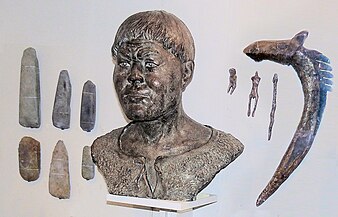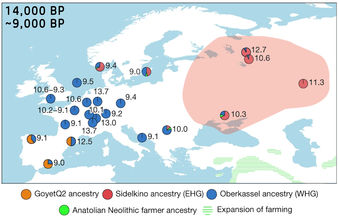Artifacts and forensic reconstruction of an eastern hunter-gatherer from the site of Yuzhny Oleny island (dated c. 8,100 BP), by M. M. Gerasimov. National Museum of Karelia.[1] Hunter-gatherers in Europe between 14 ka and 9 ka, with the main area of Eastern Hunter-Gatherers (EHG, ). Individual numbers correspond to calibrated sample dates.[2] |
In archaeogenetics, eastern hunter-gatherer (EHG), sometimes east European hunter-gatherer or eastern European hunter-gatherer, is a distinct ancestral component that represents Mesolithic hunter-gatherers of Eastern Europe.[3]
The eastern hunter-gatherer genetic profile is mainly derived from Ancient North Eurasian (ANE) ancestry, which was introduced from Siberia,[4] with a secondary and smaller admixture of European western hunter-gatherers (WHG).[5][6] Still, the relationship between the ANE and EHG ancestral components is not yet well understood due to lack of samples that could bridge the spatiotemporal gap.[5]
During the Mesolithic, the EHGs inhabited an area stretching from the Baltic Sea to the Urals and downwards to the Pontic–Caspian steppe.[7] Along with Scandinavian hunter-gatherers (SHG) and western hunter-gatherers (WHG), the EHGs constituted one of the three main genetic groups in the postglacial period of early Holocene Europe.[8] The border between WHGs and EHGs ran roughly from the lower Danube, northward along the western forests of the Dnieper towards the western Baltic Sea.[9]
During the Neolithic and early Eneolithic, likely during the 4th millennium BC EHGs on the Pontic–Caspian steppe mixed with Caucasus hunter-gatherers (CHGs) with the resulting population, almost half-EHG and half-CHG, forming the genetic cluster known as Western Steppe Herder (WSH).[10][11][12] WSH populations closely related to the people of the Yamnaya culture are supposed to have embarked on a massive migration leading to the spread of Indo-European languages throughout large parts of Eurasia.
- ^ National Museum of Karelia exhibit
- ^ Cite error: The named reference
Posth2023was invoked but never defined (see the help page). - ^ Haak, Wolfgang; Lazaridis, Iosif; Patterson, Nick; Rohland, Nadin; Mallick, Swapan; Llamas, Bastien; Brandt, Guido; Nordenfelt, Susanne; Harney, Eadaoin; Stewardson, Kristin; Fu, Qiaomei (June 1, 2015). "Massive migration from the steppe was a source for Indo-European languages in Europe". Nature. 522 (7555): 207–211. doi:10.1038/nature14317. ISSN 1476-4687. PMC 5048219. PMID 25731166.
- ^ Kozintsev, A. G. (January 4, 2022). "Patterns in the Population History of Northern Eurasia from the Mesolithic to the Early Bronze Age, Based on Craniometry and Genetics". Archaeology, Ethnology & Anthropology of Eurasia. 49 (4): 141. doi:10.17746/1563-0110.2021.49.4.140-151.
ANE makes up the principal share of the EHG (Eastern Hunter-Gatherer) autosomal component, whose content is especially high in the genomes of Mesolithic and Early Neolithic inhabitants of northeastern Europe buried at Yuzhny Oleny Ostrov, Popovo, Sidelkino, Lebyazhinka IV, etc. (Haak et al., 2015; Damgaard et al., 2018). They passed EHG on to the Yamnaya people, from whom it was inherited by several filial populations, including Afanasyevans. As early as the Mesolithic, EHG was introduced from northern Russia to Scandinavia, as evidenced by genomes of the Motala people in southern Sweden. Their ancestors had migrated there from the east along the coast of Norway, because the share of EHG in more southern populations, such as the earlier Kunda people of the eastern Baltic, is lower (Haak et al., 2015; Mittnik et al., 2018).
- ^ a b Feldman, Michal; Gnecchi-Ruscone, Guido A.; Lamnidis, Thiseas C.; Posth, Cosimo (2021). "Where Asia meets Europe – recent insights from ancient human genomics". Annals of Human Biology. 48 (3): 191–202. doi:10.1080/03014460.2021.1949039. PMID 34459345. S2CID 237348859.
- ^ Nägele, Kathrin; Rivollat, Maite; Yu, He; Wang, Ke (2022). "Ancient genomic research - From broad strokes to nuanced reconstructions of the past". Journal of Anthropological Sciences. 100 (100): 193–230. doi:10.4436/jass.10017. PMID 36576953.
- ^ Anthony 2019b, p. 27.
- ^ Kashuba 2019: "Earlier aDNA studies suggest the presence of three genetic groups in early postglacial Europe: Western hunter–gatherers (WHG), Eastern hunter–gatherers (EHG), and Scandinavian hunter–gatherers (SHG)4. The SHG have been modelled as a mixture of WHG and EHG."
- ^ Anthony 2019b, p. 28.
- ^ Haak, Wolfgang; Lazaridis, Iosif; Patterson, Nick; Rohland, Nadin; Mallick, Swapan; Llamas, Bastien; Brandt, Guido; Nordenfelt, Susanne; Harney, Eadaoin; Stewardson, Kristin; Fu, Qiaomei (June 1, 2015). "Massive migration from the steppe was a source for Indo-European languages in Europe". Nature. 522 (7555): 207–211. arXiv:1502.02783. Bibcode:2015Natur.522..207H. doi:10.1038/nature14317. ISSN 1476-4687. PMC 5048219. PMID 25731166.
- ^ van de Loosdrecht, Marieke; Bouzouggar, Abdeljalil; Humphrey, Louise; Posth, Cosimo; Barton, Nick; Aximu-Petri, Ayinuer; Nickel, Birgit; Nagel, Sarah; Talbi, El Hassan; El Hajraoui, Mohammed Abdeljalil; Amzazi, Saaïd; Hublin, Jean-Jacques; Pääbo, Svante; Schiffels, Stephan; Meyer, Matthias (May 4, 2018). "Pleistocene North African genomes link Near Eastern and sub-Saharan African human populations". Science. 360 (6388): 548–552. Bibcode:2018Sci...360..548V. doi:10.1126/science.aar8380. ISSN 0036-8075. PMID 29545507.
- ^ Lazaridis, Iosif; Alpaslan-Roodenberg, Songül; Acar, Ayşe; Açıkkol, Ayşen; Agelarakis, Anagnostis; Aghikyan, Levon; Akyüz, Uğur; Andreeva, Desislava; Andrijašević, Gojko; Antonović, Dragana; Armit, Ian; Atmaca, Alper; Avetisyan, Pavel; Aytek, Ahmet İhsan; Bacvarov, Krum (August 26, 2022). "The genetic history of the Southern Arc: A bridge between West Asia and Europe". Science. 377 (6609): eabm4247. doi:10.1126/science.abm4247. ISSN 0036-8075. PMC 10064553. PMID 36007055. S2CID 251843620.

